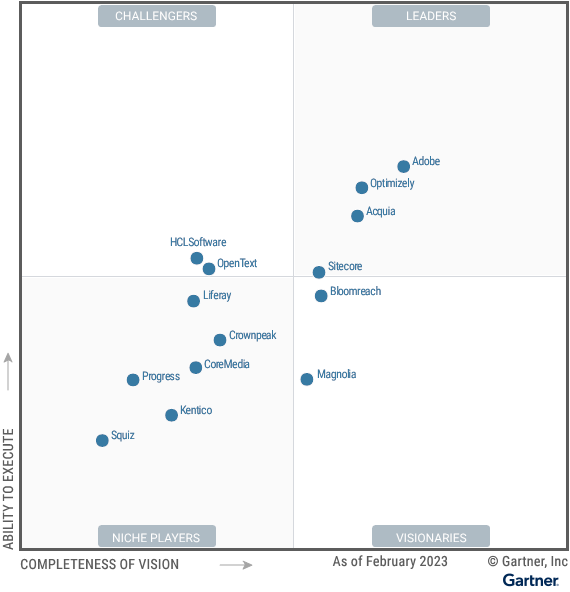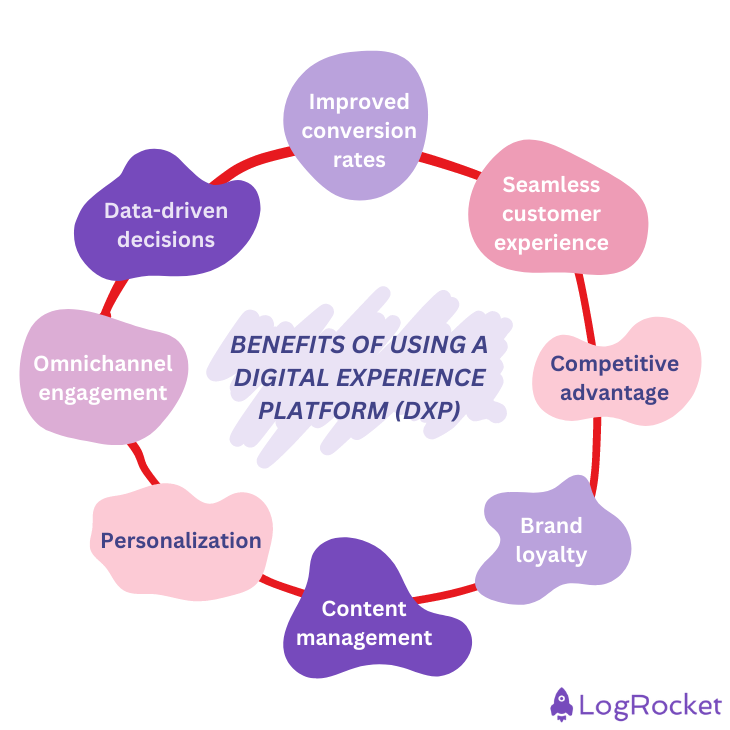Digital experience platforms (DXP) are all-encompassing software solutions that aid businesses in creating, managing, and optimizing digital experiences across a variety of channels and touchpoints. A DXP merges various tools and technologies into a single ecosystem, such as content management systems (CMS), customer relationship management (CRM), e-commerce platforms, personalization engines, analytics, and more.

The importance of DXP lies in its capacity to provide smooth and personalized user experiences across multiple digital channels. These include websites, mobile apps, social media, email, and even physical touchpoints like kiosks and IoT devices. This ability fosters customer loyalty and business growth in our increasingly digital world.
A DXP is an assembly of core technologies that collaborate to create, manage, deliver, and optimize custom digital experiences. It can be a single product or a suite of software with multiple integrated applications. The primary goal of a DXP is to collect and organize customer data to derive real value from it.
For instance, a retailer might use a DXP to offer a personalized experience that includes shopping, loyalty programs, and relevant content. Customers have the freedom to interact with the experience in a way that suits them best. As they engage more with the platform, the experience becomes increasingly tailored to their preferences.
Moreover, a DXP is an integrated and cohesive technology suite that facilitates digital journey orchestration. This process involves combining capabilities from various applications to create seamless customer experiences. These applications can either be built natively into the platform or added as integrations.
While DXPs offer similar functionalities, the 2023 Magic Quadrant report for DXP divides providers into four segments: leaders, challengers, visionaries, and niche players:

The overarching advantage of using a digital experience platform is that it enables you to create smooth and personalized user experiences across your various channels. But this benefit contains multiple layers.
Let’s take a closer look at how, specifically, companies and product teams stand to benefit by integrating a DXP:

A digital experience platform (DXP) is composed of several crucial components and capabilities that empower businesses to deliver outstanding digital experiences to their users. Here are some of the essential components and capabilities of a DXP:
Digital experience platforms (DXPs) and content management systems (CMSs) are both essential tools in the digital landscape, but they serve different purposes and offer varying functionalities.
A DXP is a more comprehensive and multifaceted platform that goes beyond content management to offer a full spectrum of tools needed to engage and satisfy today’s digitally-savvy customers. A CMS, while essential for content management, does not provide the same breadth of functionalities and integrations that a DXP does.
Let’s take a closer look at the key differences between a DXP and a CMS:
Implementing a digital experience platform (DXP) in product management can significantly enhance the customer experience, streamline processes, and boost business outcomes.
These real-world examples demonstrate how effective DXPs are at enhancing customer engagement by creating personalized experiences that lead to increased business success. Through innovative ways of building DXPs — e.g., integrating various technologies, leveraging data insights, applying product management practices — the following companies have forged meaningful connections with their customers while gaining competitive advantages.
Lego utilized a DXP to bolster its digital presence and improve the customer experience. By integrating CMS, e-commerce, personalization, and analytics capabilities into one platform, they created a more engaging online store with personalized user experiences.
Netflix employs an advanced DXP to provide personalized content recommendations to its subscribers. The platform analyzes users’ viewing patterns and preferences to curate tailored content suggestions. Thanks to its DXP, Netflix has achieved high user retention and satisfaction rates.
A key factor behind Amazon’s e-commerce success is its strategic use of a DXP. Amazon leverages user data through this platform to offer personalized product recommendations, targeted marketing, and a smooth shopping experience. Additionally, the DXP assists Amazon in optimizing its supply chain, inventory management, and improving customer support.
Adobe, a leader in creative software and digital marketing solutions, implemented a DXP to offer its users a seamless and integrated experience. Adobe’s suite of products is easily accessible and manageable through a unified platform which streamlines workflows and promotes efficient collaboration for customers. This approach helps Adobe maintain a robust customer base and high customer satisfaction.
Sephora, a renowned cosmetics retailer, incorporated a DXP into its digital strategy to offer customized beauty suggestions and virtual try-on experiences. By collecting information from customer interactions and purchases, Sephora can suggest products tailored to each individual’s needs thereby improving the overall shopping experience.
Nike has implemented a DXP that offers their customers personalized shopping experiences. By analyzing customer data and behavior, Nike can offer tailored product recommendations, content, and promotions across various digital channels. This technology helps Nike create a seamless and engaging customer journey which increases customer loyalty and sales.
L’Oreal has implemented a DXP to enhance the shopping experience for their customers. This system integrates e-commerce capabilities with customer data collection and personalized content delivery to create a seamless online shopping experience. By providing personalized beauty recommendations alongside interactive product try-on features, L’Oreal has increased user engagement and conversion rates on its digital platform.
Starbucks adopted a DXP to improve its loyalty program as well as mobile ordering experiences. This technology enables personalized promotions, rewards, and customer recommendations based on past purchases or preferences. Starbucks seamlessly integrates the mobile app with their website as well as in-store experiences ensuring consistency throughout the entire customer journey.
The process of integrating a digital experience platform (DXP) with your existing applications is as follows:
The first step in integrating a DXP with your existing systems is to evaluate and plan the integration process. This involves identifying the target applications for integration, such as content management systems, CRM platforms, ecommerce platforms, analytics tools, marketing automation platforms, and others.
It’s also crucial to define specific use cases and objectives for each integration. This helps you understand how to effectively utilize the data and functionalities from these systems within your DXP.
APIs play a vital role in facilitating smooth communication and data exchange among applications. Before integrating your systems with a DXP, it’s important to verify whether your current tools have available APIs for integration.
Reviewing the API documentation of the applications you plan to integrate with is also essential. This helps you identify available endpoints, data formats, and authentication methods that will be used during the integration process.
Security should be a top priority when integrating different systems. Implement authentication mechanisms and secure communication protocols, such as HTTPS, to protect sensitive data during transmission.
Additionally, make sure that access controls and permissions are set up correctly to uphold the security and privacy of data across all integrated systems.
Selecting an appropriate method for integration is key to ensuring seamless communication between your DXP and existing applications. Common integration methods include API-based integrations, webhooks, and data synchronization.
To determine the best approach for your needs, assess how often data updates are needed and whether real-time updates are necessary.
Comprehensive testing is crucial to ensure that the integration process is successful. Create a comprehensive test plan that covers different scenarios and cases to validate the integration functionalities and ensure the correct data flow between the systems.
Consider load testing, regression testing, and user acceptance testing as part of your comprehensive testing strategy. These tests help uncover potential performance bottlenecks and provide insights into how the integration will perform under different conditions.
These platforms offer diverse functionalities and cater to different business needs. While some are renowned for their personalization and analytics, others stand out for their flexibility, integrations, or industry-specific solutions.
As described above, the best choice of a DXP often depends on the unique requirements, budget, and strategic goals of your organization. Let’s take a high-level look at some popular DXP solutions and their key features:
To summarize, a digital experience platform (DXP) is a software solution businesses use to create customized digital experiences for their customers via various channels and touchpoints. DXPs are essential for improving user engagement, enhancing personalization, streamlining processes, and achieving better business outcomes.
Understanding and implementing a strategic DXP integration with your existing systems can help you unlock greater value for your customers and thus drive sustainable growth for your business.
Featured image source: IconScout
LogRocket identifies friction points in the user experience so you can make informed decisions about product and design changes that must happen to hit your goals.
With LogRocket, you can understand the scope of the issues affecting your product and prioritize the changes that need to be made. LogRocket simplifies workflows by allowing Engineering, Product, UX, and Design teams to work from the same data as you, eliminating any confusion about what needs to be done.
Get your teams on the same page — try LogRocket today.

Act fast or play it safe? Product managers face this daily. Here’s a smarter way to balance risk, speed, and responsibility.

Emmett Ryan shares how introducing agile processes at C.H. Robinson improved accuracy of project estimations and overall qualitative feedback.

Suvrat Joshi shares the importance of viewing trade-off decisions in product management more like a balance than a compromise.

Great product managers spot change early. Discover how to pivot your product strategy before it’s too late.